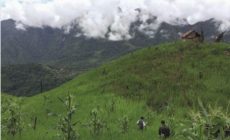Morung Express News
Mokokchung | April 9
In an achievement for community-driven ecological restoration, a total of 4,968 hectares of degraded forest land has been successfully restored across 14 villages in Mokokchung district under the Nagaland Forest Management Project (NFMP), supported by the Japan International Cooperation Agency (JICA). The update was shared during the Annual Review Meeting held at the conference hall, Whispering Winds on April 8, organised by the Divisional Management Unit (DMU) Mokokchung in collaboration with the District Advisory Committee (DAC).
Dr Sentitula IFS, Divisional Forest Officer and Head of DMU Mokokchung, delivering the keynote address, highlighted that the restoration was undertaken between 2020 and 2024. The project, implemented by the Department of Environment, Forest and Climate Change, integrates ecological recovery with socio-economic resilience through both productive and conservation-oriented forest models.
Of the total area restored, 1,059.31 hectares were developed under productive forestry models such as Jhum Agroforestry (JAF), Jhum Fallow Forestry (JFF), and Jhum Conversion to Forestry (JCF).
Another 3,910.27 hectares were brought under conservation-centric models like Jhum Conversion to Conservation (JCC) and Protection or Expansion of Community Conservation Areas (PEC). Over 998,984 saplings were planted during this period, with 1,289 hectares more targeted for restoration in 2025 and an additional 220,767 saplings scheduled for plantation.
Dr Sentitula noted that while Nagaland’s forest cover stands at 73.72%, much of it suffers from degradation due to unsustainable practices such as traditional jhum cultivation, which supports nearly 60% of the population. More than half the forests are classified as low-carbon open forests, with an average of only 12.08 tons of carbon per hectare—well below the national average of 31 tons.
Launched in 2018-19, NFMP is built around three pillars: community-based forest conservation, livelihood enhancement, and institutional capacity building. In Mokokchung, the project is being implemented across two ranges—Mokokchung Range and Changtongya Beat—covering 18 villages in four batches. Field operations began with nursery development in 2019, followed by planting activities from 2020, and ongoing monitoring since 2021.
At the heart of the project are Joint Forest Management Committees (JFMCs)—village-based bodies established under a 1997 government notification and aligned with Nagaland’s community land ownership system, where 88.3% of forest land is managed by local communities.
According to Dr Sentitula, field data has shown promising ecological recovery. According to the Forest Survey of India (2023), Mokokchung district recorded a 14.88 sq km increase in forest cover, with 46.97 sq km of open forest transitioning to moderately dense forest. The district also saw a 0.62 sq km rise in very dense forest and a notable reduction in scrubland. Notably, the JAF model recorded a sapling survival rate of 95%, underscoring its success.
Beyond ecological gains, the project has also fostered alternative livelihoods. Local Self-Help Groups (SHGs) have initiated sustainable colocasia cultivation, demonstrating the synergy between conservation and economic resilience.
However, challenges remain. The JCF model, for instance, reported a sapling survival rate below 50%, highlighting the need to scale successful models, improve monitoring, and explore carbon credit opportunities through the Mokokchung Development Fund (MDF), Dr Sentitula highlighted.
Thsuvisie Phoji, Deputy Commissioner of Mokokchung, who attended the meeting as special guest, raised concerns about the increasing frequency of forest and man-made fires, describing them as a growing threat. “Departments like fire services, police, and local councils are working round the clock, but these incidents are becoming relentless,” he said, attributing the trend to global warming and deforestation. He called for greater vigilance and community responsibility, warning that carelessness is leading to the destruction of local forests and homelands.
He also urged JFMCs to sustain their efforts beyond the 10-year funding window of the NFMP. “Real success will be measured not now, but 10 to 20 years later—when communities continue forest conservation efforts without external funding,” he stated. He commended examples where villages contributed their own resources to sustain and expand conservation projects and expressed hope that Mokokchung would serve as a model district for not just Nagaland but the entire country.
Cautioning against overreliance on synthetic products, Phoji remarked, “We can manufacture almost everything artificially—except forests. We cannot create synthetic trees that absorb CO2 and release oxygen. We must unite to protect what is still natural.” The meeting also featured field presentations by JFMC Chairpersons, an overview of GIS and FNGO activities, and a speech by Lanutoshi Aier, President of the Ao Students’ Conference (AKM), who reiterated the importance of community ownership and youth engagement in forest conservation.







 An orbiting message of peace
An orbiting message of peace The Top Viral YouTube Videos of 2017
The Top Viral YouTube Videos of 2017 What Does Your Face Say About Your Health?
What Does Your Face Say About Your Health? The last Konyak headhunters of Nagaland
The last Konyak headhunters of Nagaland










Leave a Reply
Your email address will not be published. Required fields are marked (required)